Denise Ross
Edition 658 - January 20, 2017
Edition 658 - January 20, 2017



The Law of Charts with Commentary
by Master Trader Joe Ross
Author, Trader, Trading Mentor, and Founder of Trading Educators, Inc.
WHAT SHOULD YOU TRADE?
During my private tutoring and recorded webinar, I prove to my students that what I teach can be used in any market and in any time frame.
People write to me to tell me, "All I want to trade is a 5-minute E-mini S&P 500 chart."
But why? Why would anyone want to restrict himself to one market and one time frame? There is no market in the world that is always good for trading in a single time frame. You need to look around to see exactly which markets and time frames are best suited to your personality, comfort level, account size, and current market conditions.
In fact, at Trading Educators, we are likely to trade a different market every day, and if it is the same market, we don't necessarily trade it in the same time frame as we did the previous day. The reason for that is that we want the best possible setups for the way we like to trade.
There are times when you can do just as well in the Russell 2000 ETF as you can do trading the E-mini Russell 2000 futures. Have you ever tried to trade the Norwegian Krone in the futures market? There's practically no liquidity. But you can trade it as USDNOK in the forex market as seen on the chart below. If you wanted to be short the krone, you can go long USDNOK.
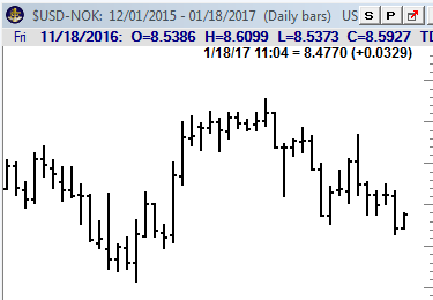
Too many traders have tunnel vision. All they can see is one market and one single time frame. Trading that way is a great way to get killed. But if you truly learn how to trade; if you truly understand The Law of Charts; if you really understand market dynamics, and the correct approach to the markets, you can trade wherever and whenever the trading is best.
© by Joe Ross. Re-transmission or reproduction of any part of this material is strictly prohibited without the prior written consent of Trading Educators, Inc.
Trading Article - Conquering Passivity
by Master Trader Joe Ross
Author, Trader, Trading Mentor, and Founder of Trading Educators, Inc.
Winning traders take decisive action. The decisions you have to make to put on winning trades are crucial to success. Where do you enter? When do you exit? How much risk will you take? Each of these questions must be addressed quickly and with strong resolution. But not all traders can make the right decision at critical moments of investing. Passivity often sets in. It can take on many forms from failing to pull the trigger to holding onto a losing trade. Sometimes, actually taking action is a form of passivity. For instance, rather than actively letting a winning trade fully come to fruition, a passive trader may close out a position early to lock in profits and avoid the unpleasant feeling of embracing and accepting uncertainty. There may be three types of passive traders: Cautious, fearful, and insecure. If one of these types is descriptive of you, consider learning how to conquer passivity by gaining awareness of the psychological mechanisms that lie beneath it.
Cautious traders are passive in an attempt to avoid risk. They obsess over any possible flaw in their trading plan. They try to seek out perfect trading information in a fruitless attempt to control the inherent uncertainty of the markets. Many times, their thorough search for all pertinent sources of information is merely an excuse for not taking on risk. But information is never fully complete. When you are trading, you are taking a risk, and you must accept the fact that no amount of perfectionism or caution will guarantee success. All that cautious traders end up doing is failing to take action.
A second type of passive trader is the fearful trader. Fearful traders don't trade to win. They constantly try to avoid losing. It's not a very satisfying way to trade. You might say, their need to avoid loss "leads to a sense of quiet desperation." Rather than enthusiastically trading the markets, and expecting success, they passively wait for their doom, which they think is inevitable. Your destiny is never set, however. By taking an active approach to trading, you'll increase the odds of realizing huge payoffs.
Insecure traders are passive because they continually seek approval. Insecure traders seek out acceptance and reassurance. They can't make a decision independently and spend hours gathering the opinions of others, and hope that other people can make key decisions for them. Their primary intention is to avoid responsibility. If someone else were the impetus for their decision, then it's never their fault when the trade goes sour. It's always someone else's fault. By putting the blame on others, the insecure trader is able to avoid facing his or her limitations. A grandiose self-view can be maintained. But looking toward others and avoiding an honest look at your abilities will lead to stagnation. Trading requires action, and fully engaging in trading activities requires a full awareness of what you're doing. You must actively look inward to your own intuitive sense of the market action and trust what your instinct tells you. Only when you are fully committed to looking at the market through your senses, and fully accepting your experience on its own terms can you trade freely, creatively and profitably.
In the end, there are no guarantees. You must take risks. The key is to find the proper balance. Risks can motivate you, but they can also overwhelm. By finding a level of risk that motivates you, but does not overwhelm you, you will stay energized and be ready to actively trade the markets rather than allow profits to pass by.
© by Joe Ross. Re-transmission or reproduction of any part of this material is strictly prohibited without the prior written consent of Trading Educators, Inc.
Instant Income Guaranteed - X Trade
Developer: Joe Ross
Administration and New Developments: Philippe Gautier
On 9th June 2016, we gave our subscribers a new type of trade on US Steel (X), which was showing accumulation on a pullback on the weekly chart.
We entered a "complex position", entered for a net credit (still working with OPM, i.e. other people's money, as usual), but with unlimited upside potential.
- On 10th June 2016, we entered the trade for a credit of $1.70 (or $170 per position).
- On 9th November 2016, we took partial profits on our long position.
- On 7th December 2016, we took new partial profits on our long position and closed our short position.
Profit: $470
Margin: $1,240
Return on Margin annualized: 176.09%
But this is only part of the story. As part of our profit maximizing strategy on these long term trades, we still have one long call position left, with a zero cost price, an extra open profit of around $1,200, and about one year left to play out.
These are low maintenance, low stress trades with lots of upside potential.
We presently have 19 of these trades opened.
Philippe
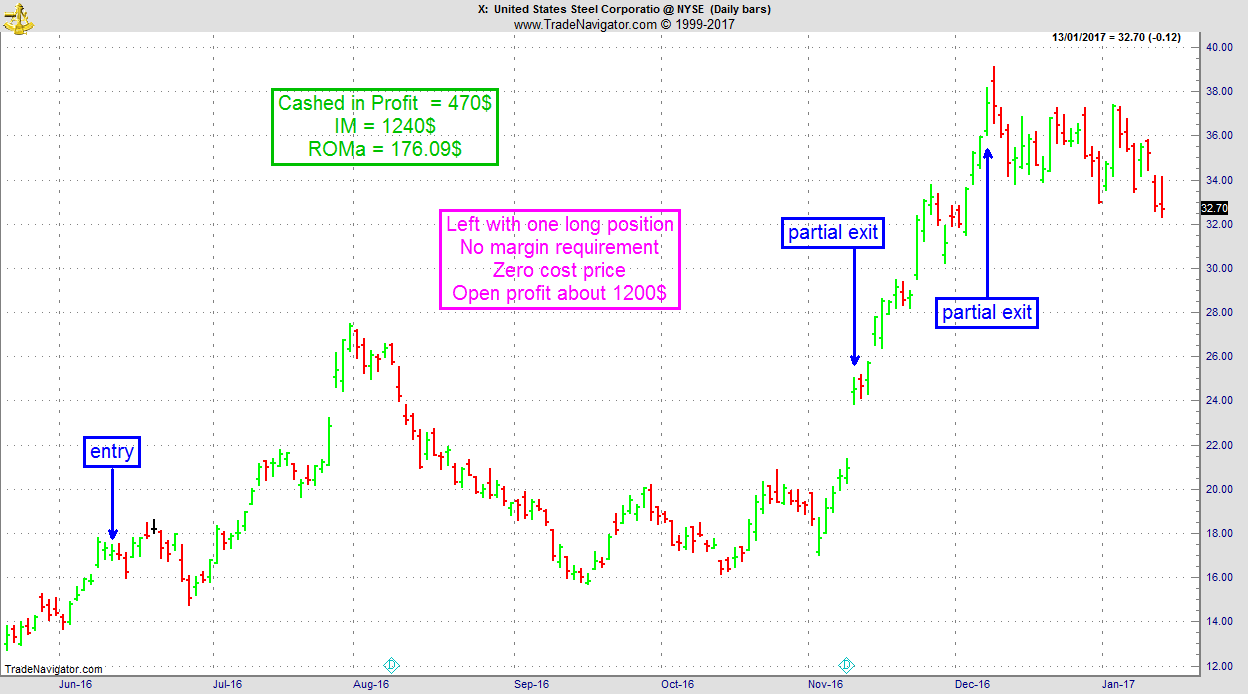
Receive daily trade recommendations - we do the research for you!
Instant Income Guaranteed
♦ SIGN UP TODAY! THIS IS WORTH THE INVESTMENT ♦

Trading Idea - GFJ17+ZCK17-2xLEQ17
by Professional Trader Andy Jordan
Educator for Spreads, Options, Swing/Day Trading, and
Editor of Traders Notebook Complete and Traders Notebook Outrights
Today I am looking at a very “strange” butterfly spread: Long 1 April Feeder Cattle and one May Corn and short 2 Live Cattle August.
I have to admit that it is difficult to find an entry into this trade by looking for chart patterns, but it is easy to see the possible support around the current level. Okay, the spread moved a bit lower in July last year but this happened when there was not enough volume in all 3 legs of the spread. Since then, the spread stayed above -$500 on a close basis. Unfortunately, there is no way to trade this spread as a single contract and we need to “leg in” into each leg separately. I would also give this spread enough room to develop and therefore a risk of about $1,000 - $1,500 per butterfly seems to be necessary.
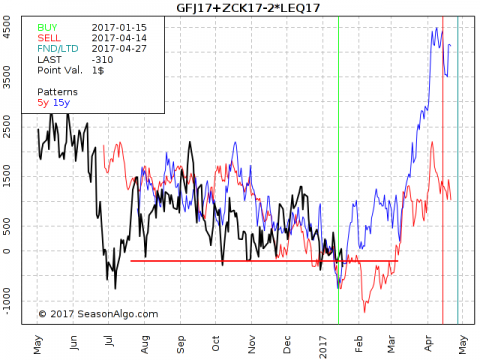
© by Andy Jordan. Re-transmission or reproduction of any part of this material is strictly prohibited without the prior written consent of Trading Educators, Inc.
 Trading Article - Indicators: Good or Bad?
Trading Article - Indicators: Good or Bad?
by Master Trader Marco Mayer
Educator for Forex and Futures, Systematic Trader, and
Creator of Ambush Trading Method, Ambush Signals, and AlgoStrats.com
One of the most commonly discussed trading topics is whether indicators are good or bad. Should a trader use them or is it just a distraction that doesn’t add anything to the "pure" price-action you can see on a simple price chart?
The answer is that making a war of opinions out of anything related to trading and thinking in terms of "good" or "bad" is kind of silly. Remember, we’re talking about trading here, not about where you can get the best Burgers, which is the best soccer team or some other question of preferences. Trading is about making money, so it’s important to ask the right objective questions and for these, there usually are objective answers.
Does the indicator you’re looking at give you an edge in the markets or not? Or if it’s an indicator supposed to provide you a specific information in an easier way, does it do its job and make your life as a trader easier?
If it does it would be crazy to not use it. An indicator is nothing else than some kind of transformation/representation of whatever data you put in there and how you’d like to see it. The same can be said about OHLC charts. If you want it really pure then you should look only at tick data as an OHLC price bar is just a summary of that.
So don’t get fooled by the "Price Action is the only way!" crowd. Of their patterns, you can ask the very same question: "Does the shown price pattern provide an edge, yes or no? If the answer is no, and that is, unfortunately, the truth for most price patterns and indicators out there, then just forget about it and move on. Again this isn’t about a question of what appeals to you or not. It’s about whether it makes you money or not.
The truth is that any indicator is only as useful as the trader’s knowledge about the indicator. Obviously just randomly adding a couple of indicators to a chart isn’t going to be helpful. You should understand pretty well what an indicator actually does, how it works and what that number it spits out tells you. Otherwise, it’s going to be very hard to know when and how to use it. Most indicators „work“ only under certain conditions. But the very same thing can be said about any price pattern out there. If you blindly trade it without having done any testing on whether it provides you can edge or not in the market/timeframe/conditions you want to trade it, you can as well use any arbitrary indicator out there!
As a systematic trader, I use a lot of indicators in one way or the other. Most of them are indicators I came up with on my own to make my life as a trader easier. Others tell me whether a certain price pattern is there or not. But I know exactly how each indicator works and what it’s actually useful for. Whether it’s indicating some OHLC based price pattern or providing some measurement of volatility that might not be that easy to recognize by just looking at a price chart.
Happy Trading!
Marco
© by Marco Mayer. Re-transmission or reproduction of any part of this material is strictly prohibited without the prior written consent of Trading Educators, Inc.
Check out our Blog!
To view previous published Chart Scan newsletters, please log in or click on "Join Us,"
shown above, to subscribe to our free "Members Only" section.
A WEALTH OF INFORMATION & EDUCATION:
Joe Ross-Trading Educators' popular free Chart Scan Newsletter has been published since 2004.
Note: Unless otherwise noted, all charts used in Chart Scan commentary were created
by using Genesis Financial Technologies' Trade Navigator (with permission).
Legal Notice and Copyright 2017 Disclaimer - Published by Trading Educators, Inc.
Chart Scan is a complimentary educational newsletter.
© by Trading Educators, Inc. Re-transmission or reproduction of any part of this material is strictly prohibited without prior written consent.
Edition 657 - January 13, 2017
Edition 657 - January 13, 2017

 Ambush Trading Method - Performance Update
Ambush Trading Method - Performance Update
by Master Trader Marco Mayer
Educator for Forex and Futures, Systematic Trader, and
Creator of Ambush Trading Method, Ambush Signals, and AlgoStrats.com
As we’re heading into 2017, I thought it was a good time to reflect on the trading performance of Ambush in 2016.
To do so, let’s look at the performance of the Ambush All Stars Small Portfolio consisting of:

The following Performance Report includes trading costs of $5 commissions round turn and 1/2-tick slippage per market order. We’re assuming to get 1-tick slippage on 50% of all executed stop-market or market orders, and of course, no slippage on limit-orders.
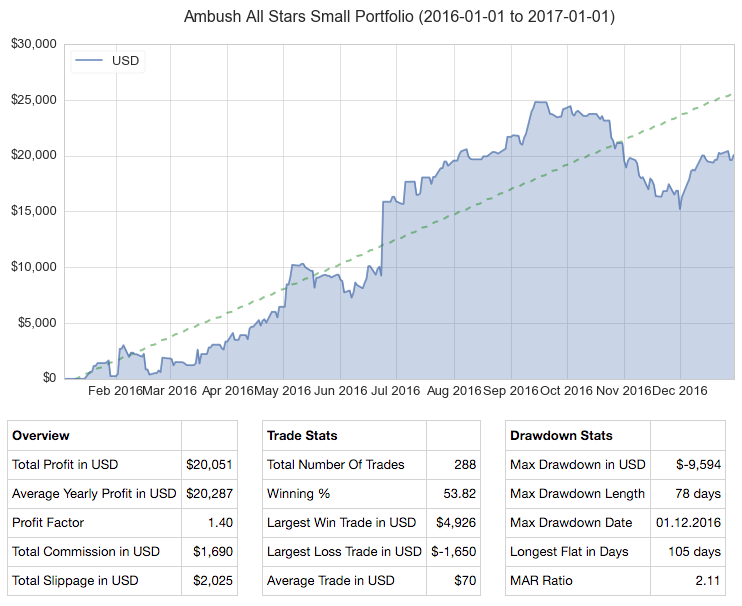
Now, there’s not much to say about that performance report. 2016 has simply been an exceptional year for Ambush traders and all performance metrics look just as a trader would wish for. Out of 12 months there have been only 2 losing months (October/November). The resulting drawdown of these two happening in a row wasn’t very nice, but compared to the overall profits of the year, it was still very moderate. This gives us a MAR Ratio of over 2 which is still excellent.
You can learn more about Ambush and Ambush Signals on the Ambush Signals Website.
Watch my short presentation to find out more about Ambush Signals.
Join Marco Mayer - Ambush Signals!
© by Marco Mayer. Re-transmission or reproduction of any part of this material is strictly prohibited without the prior written consent of Trading Educators, Inc.

Trading Article - Do Something Else!
by Professional Trader Andy Jordan
Educator for Spreads, Options, Swing/Day Trading, and
Editor of Traders Notebook Complete and Traders Notebook Outrights
You need to find other things to do while padding the time waiting for better trades. Try to study the markets or different ways of trading, or simply do something completely different like going to the beach. It is critical that you learn to enjoy yourself in ways other than being in a trade.
The fact is, if you are trading in a professional way, you are out of the market much of time. So you need to think of ways to fill this time. Trading is not a full-time job where a person works 8 hours a day. Also, trading doesn't get better by trading more. The opposite is often the case.
When you are not satisfied with your trading, try to reduce the number of trades instead of putting on more trades. This might help to move your trading to a higher level and you might get better results.
© by Andy Jordan. Re-transmission or reproduction of any part of this material is strictly prohibited without the prior written consent of Trading Educators, Inc.

The Law of Charts with Commentary
by Master Trader Joe Ross
Author, Trader, Trading Mentor, and Founder of Trading Educators, Inc.
Spreads
The years go by quickly. Seems like yesterday that I presented a webinar for the CBOT, in which I showed how to stay in a trend using the Volatility Stop Study (VSS).
The market I used was CBOT gold. Since that time, gold has dramatically changed, but what I want to show hasn’t changed at all.
One person wrote to me doubting that I could have used the VSS to get into the gold uptrend until it was too late. That was not at all true. I submit that it is quite possible to have used VSS in conjunction with The Law of Charts to get into and out of the gold trend, but also to have used VSS along with The Law of Charts to get into and remain with the gold downtrend.
Furthermore, there was no need to change the VSS parameters in order to make use of a combination of The Law of Charts, the Traders Trick Entry (TTE), and the VSS. The long entry into the uptrend could have been made in several places. For example, the breakout from the trading range could have been set lower. There was a Ross hook (first failure to move higher after a breakout from consolidation) lower than the Ross hook that gave the TTE shown for long entry. The chart below tells the whole story.
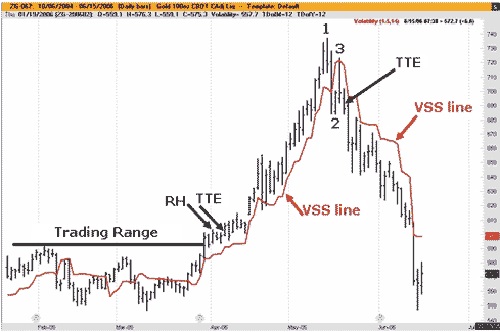
© by Joe Ross. Re-transmission or reproduction of any part of this material is strictly prohibited without the prior written consent of Trading Educators, Inc.
Trading Article - Support and Resistance
by Master Trader Joe Ross
Author, Trader, Trading Mentor, and Founder of Trading Educators, Inc.
I received a couple of emails asking whether or not I believe in support and resistance. In fact, one subscriber said if I didn't believe in support and resistance, then I couldn't possibly believe in trend! Why? Because in all cases the situation ends.
Here's what I believe: The trend is your friend until the end. The swing is the thing until it goes "ding."
What is support and what is resistance? Are those not simply convenient terms to describe an area of fair value? Prices bounce off of those areas of so-called support and they bounce off of areas of so-called resistance. Why? Because temporarily no one is willing to sell for less than "support" and no one is willing to pay more than "resistance." "Support" and "resistance" are equally as mythological as "trend." Why do I say that?
Every market is in a trading range between the highest price it ever achieved (resistance) and the lowest price it ever reached (support). So what is all that stuff in-between? Can we call the junk in between "support" and "resistance?" What are trends and swings? Are they not simply connectors connecting the temporary areas of fair value? So-called support areas fail to support, are broken, and are connected to a lower fair value area by a swing or trend. So-called resistance areas fail to resist, are broken, and are connected to a higher fair value area by a swing or trend.
Trend lines and swing lines are also broken, and lead to areas of fair value, where prices chop sideways for awhile. So, what's the bottom line of all this clap-trap about support, resistance, swings, and trends?
As far as I'm concerned, the only thing that counts is whether or not you have found a way to make money from any of this. If you are able to make money when prices bounce off of so-called support and resistance, then congratulations, you have probably made it as a trader. If you have found a way to make money from trends or swings, or have found a way to make money from broken trend or swing lines, then you deserve praise and are well on your way, or have already succeeded as a trader. The rest is just a mincing of words — semantics. Support, resistance, trend, swing — all are nothing more than ways to identify what prices appear to be doing. Any one of them can see the beginning of the end with the next price bar. If you tell me prices are at support, I will probably know what you mean. That is all the word "support" is good for! If you tell me prices are at "resistance," I will probably know what you mean. The same thing is true for the words "trend" and "swing" — I will probably know what you mean. We will have found a common way to communicate to one another as to the condition and location of prices.
Do I believe in support, resistance, trends, and swings? The answer is no! I do not believe in any of it. What I do believe, most of the time, are the numbers on the statement of my trading account. If they are getting bigger, then I am winning.
© by Joe Ross. Re-transmission or reproduction of any part of this material is strictly prohibited without the prior written consent of Trading Educators, Inc.
Instant Income Guaranteed - VLO Trade
Developer: Joe Ross
Administration and New Developments: Philippe Gautier
On 25th Oct 2016, we gave our IIG subscribers the following trade on VLO, for which we expected a retracement. We decided to sell price insurance as follows (we were filled on a GTC order on 2nd Nov 2016 at our minimum price):
We entered a "complex position" for a net credit (still working with OPM, i.e. other people's money, as usual), but with unlimited upside potential.
- On 2nd November 2016, we sold to open VLO Dec 16, 2016 50P @ $0.45, i.e. $45 per option sold, with 44 days to expiration, and our short strike below a major support zone, about 13% below price action.
- On 9th November 2016, we bought to close VLO Dec 16, 2016 50P @ $0.20, after 7 days in the trade, for quick premium compounding
Profit: $25
Margin: $1,000
Return on Margin annualized: 130.36%
We have also added new types of trades for our IIG daily guidance, "no loss" propositions with unlimited upside potential, still using other people's money to trade (see recent EWZ example in Newsletter Edition 649, log in to our members only area).
Philippe
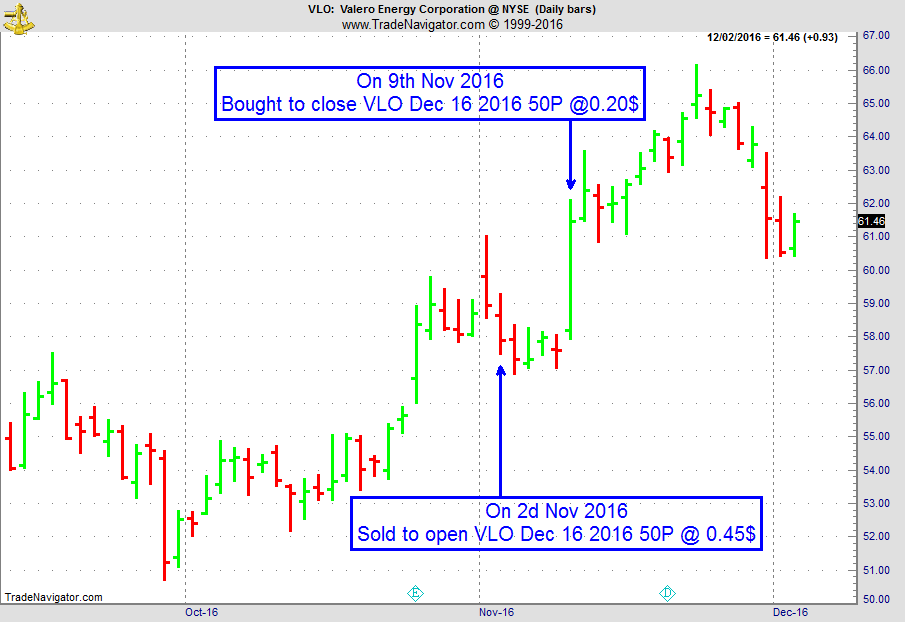
Receive daily trade recommendations - we do the research for you!
Instant Income Guaranteed
♦ SIGN UP TODAY! THIS IS WORTH THE INVESTMENT ♦
Check out our Blog!
To view previous published Chart Scan newsletters, please log in or click on "Join Us,"
shown above, to subscribe to our free "Members Only" section.
A WEALTH OF INFORMATION & EDUCATION:
Joe Ross-Trading Educators' popular free Chart Scan Newsletter has been published since 2004.
Note: Unless otherwise noted, all charts used in Chart Scan commentary were created
by using Genesis Financial Technologies' Trade Navigator (with permission).
Legal Notice and Copyright 2017 Disclaimer - Published by Trading Educators, Inc.
Chart Scan is a complimentary educational newsletter.
© by Trading Educators, Inc. Re-transmission or reproduction of any part of this material is strictly prohibited without prior written consent.
Edition 656 - January 6, 2017
Edition 656 - January 6, 2017

“We all get the exact same 365 days. The only difference is what we do with them.” – Hillary DePiano
Start your year off right with a free EBook "A Trader's Musings: A compliation Of Observations, Thoughts and Lessons From Over 50 Years of Trading" by Joe Ross. It's available at Amazon for free from January 6th through January 8th. Click here to get your copy. If you don't have a Kindle, you can download a free app.

Trading Idea - Cotton Butterfly -CTH17+2CTK7-CTN17
by Professional Trader Andy Jordan
Educator for Spreads, Options, Swing/Day Trading, and
Editor of Traders Notebook Complete and Traders Notebook Outrights
While outright futures in the so called “Softs” are usually difficult to trade, I like to trade spreads because they usually behave less “crazy”. Today I want to look into a Cotton Butterfly shown on the seasonal chart below. At the first look the spread looks kind of wild but at a closer look you might notice only the big moves, like the down move from November into January really matter in terms of US$. All the rest is just noise. The spread is also following its seasonal patter nicely and the seasonal up-move right in front of us looks promising.
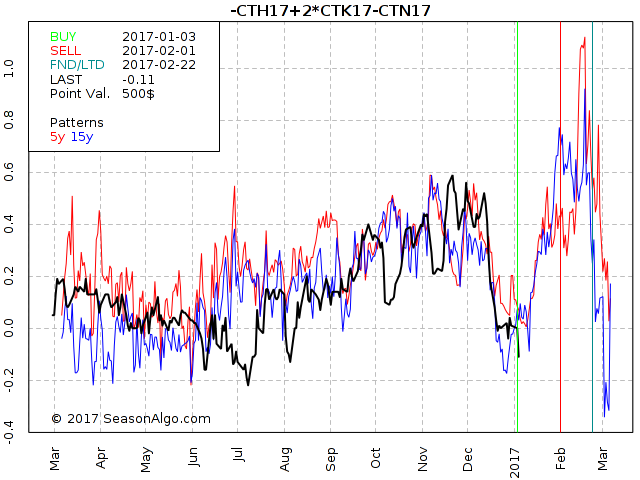
If you want to know how we trade this spread in Traders Notebook, please follow the link below. There is a special deal available for the ones new to our Newsletter.
Yes, show me how you do it, click here!
© by Andy Jordan. Re-transmission or reproduction of any part of this material is strictly prohibited without the prior written consent of Trading Educators, Inc.
 Trading Article -Why You Can Still Lose Money Winning 99% of Your Trades
Trading Article -Why You Can Still Lose Money Winning 99% of Your Trades
by Master Trader Marco Mayer
Educator for Forex and Futures, Systematic Trader, and
Creator of Ambush Trading Method, Ambush Signals, and AlgoStrats.com
I’m sure you’ve all seen advertisements of trading systems that have 95% winning trades. And traders tend to get all excited when they see a high win rate. But while having a high win rate is nice, it can also be a very misleading performance metric.
The winning rate tells you how much percent of the trades in a backtest (or real past trades) have been winning trades. So if you have 100 trades in total, and 75 of those trades closed with a profit, you have a winning rate of 75%. Now the first thing to notice here is how those winning trades are defined. Are breakeven-trades included? What about commissions? If you have 100% winning trades in the E-Mini Dow Future and each of those trades was closed at 1 tick profit ($5) and you pay $7.50 per round turn, you actually lost money even if you hit your profit target 100% of the time.
Which leads us to the next fact. And that is that without knowing how much money was made on the winning trades vs. the losing trades, the winning rate is completely useless. Here’s an extreme example. Let’s say you have 90 out of 100 winning trades, a winning rate of 90%. Sounds great right? But what if on average you had an average profit of $100 per winning trade ($100 x 90 = $9000) but an average loss of 1000$ per losing trade ($1000 x 10 = $10000)? Right you have lost $1000 even with a winning rate of 90%. Of course this also works the other way around, if you only have 10% winners, but those are 10 times the size of your 90% losing trades, you’ll come out ahead!
Here things get interesting from a psychological point of view. Most traders are not ready to trade a strategy that only wins just 10 out of 100 times. Even if it’s numbers look amazing in the long run and it’s a really good system. Most traders simply can’t deal with this as it’s going to have long flat periods and you can easily have 10 and often 20 or more small losing trades in a row.
On the other side usually the drawdowns will be much steeper trading a system with a high win rate. When it finally hits those big losing trades, months of profits can be destroyed within a single day.
So to sum this up, the winning % is a key number to watch out for but it’s far less important than most traders think and without additional information completely useless. So you shouldn’t get all excited if you see a very high winning rate right away.
All of the 99% winning trade systems that try to capture a few pips on each trade I’ve seen in the past have blown up sooner or later. And any such systems that will come up in the future will end up in the same way. It’s always a ticking time bomb and the longer it’s been running and making money - the higher the odds are it will implode soon.
Happy Trading!
Marco
© by Marco Mayer. Re-transmission or reproduction of any part of this material is strictly prohibited without the prior written consent of Trading Educators, Inc.

The Law of Charts with Commentary
by Master Trader Joe Ross
Author, Trader, Trading Mentor, and Founder of Trading Educators, Inc.
Time Independent Charts
There is something I want to point out about trading methods. Very often you have to be discretionary when trading them. For example, we discovered that with one of the methods we used to use, 100% of the time the method made 2 1/2 - 3 points per contract very soon after entry. To use the method you had to do as we suggested and take something out of the trade as soon as you could. That meant trading at least 2 contracts—one for a short-term objective and the other to stay with the trade as long as possible.
Every method comes with a stated objective; however, discretion dictated that it was advisable to take some profit out of the trade as soon as it was possible to see at least 100 (it was up to the trader as to the amount). That way a trader was being paid to trade.
We told method users to not let greed overcome them by trying to get the stated objective every time.
During the time the method was working I took a trade in corn. The trade lost if I would have stayed in until I was stopped out. But there was ample opportunity to have taken something out of the trade. Discretion is what makes a method different from a mechanical trading system. When you know that a high percentage of the time you can make 125-150 dollars from the circumstances that created the trade entry, then isn't it wise to ensure that you are paid to trade? Take some profit and move your stop to breakeven. If you are stopped out, you will still be profitable or have mitigated any loss.
The long entry (a) was at 260 dollars. Prices moved as high as 263.50 dollars, i.e. 3.5 points = 175 dollars /contract before being stopped out at breakeven the same day. If I stayed in, this amount of profit or slightly less was available on 2 consecutive trading days.
The short entry (c) was at 252.50 dollars. Prices moved as low as 248.50 dollars after entry that same day; 4 points = 200 dollars before being stopped out the following day on a gap open at 250.50 dollars. The net gain available was 2 points = 100 dollars. If I stayed in, there was still another opportunity to have come out of the trade with a nice profit. The following day prices gapped down and 4 1/2 points = 225 dollars were available. Taking something there and moving my stop to breakeven would have avoided suffering a loss on the trade.
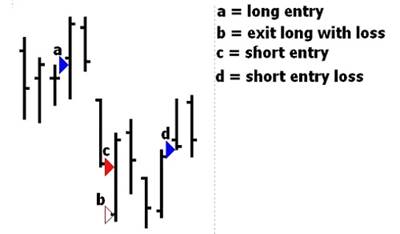
© by Joe Ross. Re-transmission or reproduction of any part of this material is strictly prohibited without the prior written consent of Trading Educators, Inc.
Trading Article - Chess and Trading. What do you think?
by Master Trader Joe Ross
Author, Trader, Trading Mentor, and Founder of Trading Educators, Inc.
Although I haven't the faintest idea of how to play chess, it certainly seems like a great idea. I imagine you can improve stock and futures trading by learning how to play chess. It might also help to develop an interest in physics. Every trader should learn to develop his problem-solving and pattern recognition abilities. I’ve been told that nothing does this better than learning how to play chess. Some of the first computer algorithms were designed to play chess. Just as chess taught the computer how to think, it seems likely chess can teach traders how to think more logically and effectively. Chess is something that might be taught in the first grade through high school in all schools to help children develop problem-solving abilities, and to create self-confidence and self-reliance. Chess, when taught to under-privileged children, was responsible for the greatest overall grade improvement for all students on all levels. Of course no one knows for sure what the social impact of such a plan might be. What about the kid who really has trouble seeing ahead; kids who have dyslexia like me? Pattern recognition is the key to understanding bar chart structure. Variations of similar patterns are constantly occurring in the markets. Prices move either up or down 100% of the time. Truly, prices do not move sideways. Markets move sideways, not prices. If a price moves, it is either up or down. Sideways for the market indicates virtually all price movement within a certain range. A key to correct technical analysis is simplicity; breaking the market down to its basic price structures for comparisons of highs, lows, opens and closes within various time periods. Profitable trading can be derived from recognition of simple recurring price patterns based on the action, reaction, and interaction of market perception.
© by Joe Ross. Re-transmission or reproduction of any part of this material is strictly prohibited without the prior written consent of Trading Educators, Inc.
Receive daily trade recommendations - we do the research for you!
Instant Income Guaranteed
♦ SIGN UP TODAY! THIS IS WORTH THE INVESTMENT ♦
Check out our Blog!
To view previous published Chart Scan newsletters, please log in or click on "Join Us,"
shown above, to subscribe to our free "Members Only" section.
A WEALTH OF INFORMATION & EDUCATION:
Joe Ross-Trading Educators' popular free Chart Scan Newsletter has been published since 2004.
Note: Unless otherwise noted, all charts used in Chart Scan commentary were created
by using Genesis Financial Technologies' Trade Navigator (with permission).
Legal Notice and Copyright 2017 Disclaimer - Published by Trading Educators, Inc.
Chart Scan is a complimentary educational newsletter.
© by Trading Educators, Inc. Re-transmission or reproduction of any part of this material is strictly prohibited without prior written consent.
Edition 655 - December 30, 2016
Edition 655 - December 30, 2016
New Year's Edition



Final Thoughts
by Master Trader Joe Ross
Author, Trader, Trading Mentor, and Founder of Trading Educators, Inc.
In a few days we begin a new year. Are you ready? Have you taken time to relax, make plans, and do a bit of self-examination? At Trading Educators we’ve done that, and we will be ready for 2017.
From where we sit it look as if the markets could be pretty wild, especially during the first quarter. The world is balancing on the edge of a razor blade, and there’s no telling what will fall and when. The fact is that maybe very little will fall and certain markets will race higher. 2017 looks to be a year where more than ever before, you will need to be in the right place at the right time. Crude oil could easily hit $60 a barrel. Gold could continue down below $1,000 before ultimately rising to as high as $2,500 by the end of the year.
If Mr. Trump and the World Trade Organization come to an agreement, look for the dollar to be devalued by close to 15%. It will be done in a way that few realize or expect. Imports will be taxed as a sort of semi-vat, while exports will be subsidized. The net effect will be to devalue the dollar. Few if any are talking about this, but it is real and the new administration will try hard to push it through. If it succeeds, it will affect all global trade. We are talking about something truly major.
If nothing else, 2017 promises to be exciting and will offer many opportunities to trade yourself into wealth. As usual, Trading Educators will be there to help you do it. We are traders, not investors, and because of that, we are able to go to wherever the money is being made. As traders, we need not do all the guessing and research that investors have to do. We don’t just write about trading, we actually do it. We always have skin in the game.
We hope you will join us for a successful 2017. We intend to be profitable, and want you to ride along with us.
Happy New Year to you all.
JR
© by Joe Ross. Re-transmission or reproduction of any part of this material is strictly prohibited without the prior written consent of Trading Educators, Inc.
Take advantage of our year-end specials!
Order the "Trading All Markets" Recorded Webinar and
receive a FREE 30-Minute Q&A with Joe Ross, valued at $200!
Check out our Blog!
To view previous published Chart Scan newsletters, please log in or click on "Join Us,"
shown above, to subscribe to our free "Members Only" section.
A WEALTH OF INFORMATION & EDUCATION:
Joe Ross-Trading Educators' popular free Chart Scan Newsletter has been published since 2004.
Note: Unless otherwise noted, all charts used in Chart Scan commentary were created
by using Genesis Financial Technologies' Trade Navigator (with permission).
Legal Notice and Copyright 2016 Disclaimer - Published by Trading Educators, Inc.
Chart Scan is a complimentary educational newsletter.
© by Trading Educators, Inc. Re-transmission or reproduction of any part of this material is strictly prohibited without prior written consent.
Edition 654 - December 23, 2016
Edition 654 - December 23, 2016


From the Staff at Trading Educators,
wishing you a very Merry Christmas and a Happy New Year!

Season Greetings and End of the Trading Year Thoughts
by Master Trader Joe Ross
Author, Trader, Trading Mentor, and Founder of Trading Educators, Inc.
Dear friends,
I keep wondering where 2016 went and now we are looking at 2017. 2016 just flew by, but lots of things happened. We finished the development of our new website. We introduced some new products, and we received lot of messages from you about your trading successes.
For me the milestone has been the continued success of our Instant Income Guaranteed program. We are now over 3 years without a losing trade. Do you know of anyone else who can say that?
As for 2017, we are expecting much turmoil and wild volatility in virtually all markets. We are living in interesting times. We are making every effort to be able to guide you safely through what we see ahead.
Today, as I write this, I personally begin my time away from the markets. It has been a lifelong habit to stay away from mid December until the end of the first week in January. The markets can be pretty crazy in the latter days of the year that will end, and the first days of the year that is coming. As a company, we take time to be grateful for what we have, and to think, plan, and just relax. It’s amazing how getting away can make things more clear.
However, this is the time of the year when I want you to know that we are thinking about you and how we can better serve. And please do let us know what you would like to see on our website. Hearing from you in addition to making what we offer, whether free or for a price, is the only way we can truly stay connected.
At Trading Educators we are very much aware that our main purpose is creating new value. That keep us busy evaluating and improving what we do and gives us the impetus to come up with something new.
We truly hope you will do the same in your own lives. Stop taking any new trades, carefully monitor what you already have and get as far away from the business of trading as you possibly can, until we are a week into 2017.
We wish you a wonderful holiday season. Have many happy days between now and the end of the year and then beyond as we sail into 2017.
All the best all the time,
JR
© by Joe Ross. Re-transmission or reproduction of any part of this material is strictly prohibited without the prior written consent of Trading Educators, Inc.
$$ Bonus $$
Purchase the "Trading All Markets" Recorded Webinar and receive a 30-MINUTE Question and Answer session with Joe Ross, valued at $200!

Christmas Time is Here
by Professional Trader Andy Jordan
Educator for Spreads, Options, Swing/Day Trading, and
Editor of Traders Notebook Complete and Traders Notebook Outrights
As always during the last days of the year, I like to look back to see what happened in 2016 and what changes I would like to make for the next year.
While 2015 was not very productive, 2016 was much better and positive in all 3 different categories: Spread Trading, Options Trading, and Outright Futures Trading. Especially spread trading which was doing great in 2016 after not doing so well in 2015. Options trading was very slow this year and we had only a few trades in 2016, but finished the year positive almost at equity highs! And our new Outright Trading Service that started the end of July is already showing nice numbers.
Honestly, if I can stay on this track in 2017, I will be happy! OK, I’d like to get a few more options trades and maybe a few more spread trades, but all in all I’d be happy to repeat the results in 2017.
I am wishing all of you a great Christmas time, hopefully with your family and friends. I will shut down my trading office for a week and will be back on the 2nd to check the markets.
 Merry Christmas,
Merry Christmas,
Andy Jordan
© by Andy Jordan. Re-transmission or reproduction of any part of this material is strictly prohibited without the prior written consent of Trading Educators, Inc.

 Enjoy the Holidays
Enjoy the Holidays
by Master Trader Marco Mayer
Educator for Forex and Futures, Systematic Trader, and
Creator of Ambush Trading Method, Ambush Signals, and AlgoStrats.com
Dear Traders,
I'd like to thank all of you for a great year 2016! I really enjoyed being in exchange with many of you on a regular basis.
I'll spend the next two weeks with my family and friends, with my mind far away from the markets. That's what I strongly suggest to do during these days of low liquidity. Just do what everyone else does and relax during this time. It's often the only two weeks of the year where I'm really 100% away from the markets as I usually keep on trading my systems during vacations if somehow possible. So I'm always looking forward to that XMAS break also knowing how eager I'll be to resume trading after a two weeks break. Just love that feeling to start into a new year with a clean slate, especially as my trading results have been somewhat mixed in 2016.
So I'd like to wish all of you a Merry Christmas and a Happy New Year 2017. Enjoy the holidays with your family and friends, and I'm looking forward to a great trading year 2017 with you!
Happy Trading!
Marco Mayer
© by Marco Mayer. Re-transmission or reproduction of any part of this material is strictly prohibited without the prior written consent of Trading Educators, Inc.

Check out our Blog!
To view previous published Chart Scan newsletters, please log in or click on "Join Us,"
shown above, to subscribe to our free "Members Only" section.
A WEALTH OF INFORMATION & EDUCATION:
Joe Ross-Trading Educators' popular free Chart Scan Newsletter has been published since 2004.
Note: Unless otherwise noted, all charts used in Chart Scan commentary were created
by using Genesis Financial Technologies' Trade Navigator (with permission).
Legal Notice and Copyright 2016 Disclaimer - Published by Trading Educators, Inc.
Chart Scan is a complimentary educational newsletter.
© by Trading Educators, Inc. Re-transmission or reproduction of any part of this material is strictly prohibited without prior written consent.
Edition 653 - December 16, 2016
Edition 653 - December 16, 2016

“You have to find something that you want to accomplish, that you want to achieve…There has to be some goal that you set for yourself and, after you’ve reached that goal, you set a new one. You always have to be shooting for something, striving for something.” Larry Fitzgerald

Trading Idea
by Professional Trader Andy Jordan
Educator for Spreads, Options, Swing/Day Trading, and
Editor of Traders Notebook Complete and Traders Notebook Outrights
Andy is looking into a seasonal Crude Oil spread going long June and short May.
© by Andy Jordan. Re-transmission or reproduction of any part of this material is strictly prohibited without the prior written consent of Trading Educators, Inc.
 Trading Article - Are you an efficient Trader?
Trading Article - Are you an efficient Trader?
by Master Trader Marco Mayer
Educator for Forex and Futures, Systematic Trader, and
Creator of Ambush Trading Method, Ambush Signals, and AlgoStrats.com
Most traders start out with a dream. And usually part of that dream is that once you’re a successful trader you’ll have a lot more time for the things in life you enjoy spending time with. Your family, friends, hobbies, spend time in nature and start other business opportunities you’ve been dreaming of realizing. Besides making money, for many the main reason to start trading is actually that they no longer want to spend 40 hours a week sitting in a office staring at a screen.
Unfortunately many traders end up doing the exact opposite of that. Staring at their screens for hours each day, looking at charts and quotes. They don’t really have a precise plan of their trading day. Instead they wake up, turn on their charts and wait for what they perceive as a trading opportunity. No need to say that this often leads to overtrading, but let’s say our trader has matured enough to be mostly free from such flaws.
Still being an active day trader he’s trading a lot in and out during the day, but being very talented he usually comes out ahead at the end of the trading day. Trading the E-Mini S&P 500 he manages to make a profit of 2 points a day on average. He’s trading two contracts so that’s 2.0 x $50 x 2 = $200. Doing 10 trades on average each day, paying $5 round turn per trade, that’s 10 x 2 x $5 = $100 commissions we have to subtract. So his actual profit after commissions is $100. Trading for 8 hours each day, that’s $12.50 per hour…for doing a quite exhausting job! Ouch.
Let’s have a look at our second trader. He knows his business very well after having invested a considerable amount of time and money to learn about the markets. Our second trader trades a system with precise trading rules, also in the E-Mini S&P 500. Let’s call it Ambush. He knows exactly at what times of the day he has to take action. In his case, when to place his entry order and when to exit his positions each day. This way he can easily plan his day, knowing that he won’t have to watch the markets at all. Being a professional he takes his trading business very seriously and religiously tracks each trade, checks his fill prices and so on. Still he doesn’t need more than 10 minutes each day to run his trading business. On average he makes about $105 per trade per contract. Never making more than one trade a day, he just has to subtract $5 commissions which leaves him with $100. As he just needs 10 minutes each day to place his orders, that’s $600 per hour on the days where he actually trades! For doing a not very exhausting job…
What a difference compared to our chart watcher! Hope you see the light here. This is huge, and once you realized this truth you can make a big step forwards in your trading career. Herein lies the reason why I decided to move towards systematic trading many years ago. First of all watching charts all day does get really boring once you no longer trade for the excitement, and I had a very different dream of what my days would look like as a trader. But even more importantly I can use all that freed up time for other business ideas, hobbies, to create new systems and to write articles like this one and make additional money helping other traders.
At least I’d suggest that even if you’re day trading discretionary, take your time to really learn about the markets you’re trading. Get some statistics and you’ll discover that every market has times during the day where it makes most sense to trade. Focus your trading activity on these time periods. They’re hardly changing over time so you can plan your trading day nicely. Truth is that most of the time it simply is a waste of time and money to day trade. I can almost guarantee you that you’ll make more money this way than trading all day long, especially after subtracting trading costs.
Happy Trading!
Marco
© by Marco Mayer. Re-transmission or reproduction of any part of this material is strictly prohibited without the prior written consent of Trading Educators, Inc.

The Law of Charts with Commentary
by Master Trader Joe Ross
Author, Trader, Trading Mentor, and Founder of Trading Educators, Inc.
Spreads
I was cruising through my charts one morning looking for an easy spread to trade. I saw that the spread between long Lean Hogs, and short Live Cattle had reached an extreme and was beginning to bottom out. Looking at the prices themselves, I saw cattle price possibly rising, while hog prices continued to fall. I thought to myself, "Aha! Here is my opportunity for a simple observation spread."
The markets are full of these kinds of spreads, if you just look for them. Because cattle and hogs trade with equal point values, it is not necessary to use multipliers to truly see whether or not the spread is making money. Nevertheless, I wanted to see the dollar value of the spread, so I multiplied each leg of the spread by its full point value of $400. That means I entered the spread as 400*LE - 400*HE, and brought up the chart fully expecting to see some kind of entry point. It was there, a 1-2-3 low.

© by Joe Ross. Re-transmission or reproduction of any part of this material is strictly prohibited without the prior written consent of Trading Educators, Inc.
Trading Article - Do you think that what this guy wrote is true?
by Master Trader Joe Ross
Author, Trader, Trading Mentor, and Founder of Trading Educators, Inc.
"You can get ahead of yourself in this game, and it’s dangerous to get cocky. But I’ve had times where for an hour I could do no wrong. I’m trading and 99 percent of the trades are good, they’re all for 30 or 50 contracts, and I’ll make 10 grand. Then I’ll overextend myself and maybe buy 10 or 15 contracts, fighting the trend just because I know prices have hit a support level. Then prices blow through that support and I can’t get out without losing half of what I made earlier. When that happens, you’ve just got to sit back, take a deep breath, drink a glass of water, and get back in."
I think that there is some truth in what was written, but there is also a lot of bad advice there as well. You can get ahead of yourself in trading – and trading is not a game, it is a business in which it is dangerous to get cocky. We’ve all had our “magic” moments when we could do no wrong. But a truly great trader will learn to take his money off the table and be satisfied with what he made. It is the greedy trader who overextends himself. It is the foolish trader who fights the trend. It is an even greater fool who believes that there is such a thing as “support.” The foolish advice here is that whoever wrote what you quote readily admits that prices blew through so-called support, which makes it not support at all! He has already proved he is a fool by overtrading his account at what he determined to be support. Now he tells you to continue overtrading by gritting your teeth and jumping back in. Whoever wrote that “advice” sounds like a real blow-hard. He claims to trade big-time, but I don’t know any truly great traders who make that many mistakes and then pass it off as advice!
© by Joe Ross. Re-transmission or reproduction of any part of this material is strictly prohibited without the prior written consent of Trading Educators, Inc.
Check out our Blog!
To view previous published Chart Scan newsletters, please log in or click on "Join Us,"
shown above, to subscribe to our free "Members Only" section.
A WEALTH OF INFORMATION & EDUCATION:
Joe Ross-Trading Educators' popular free Chart Scan Newsletter has been published since 2004.
Note: Unless otherwise noted, all charts used in Chart Scan commentary were created
by using Genesis Financial Technologies' Trade Navigator (with permission).
Legal Notice and Copyright 2016 Disclaimer - Published by Trading Educators, Inc.
Chart Scan is a complimentary educational newsletter.
© by Trading Educators, Inc. Re-transmission or reproduction of any part of this material is strictly prohibited without prior written consent.
MMtestlayout
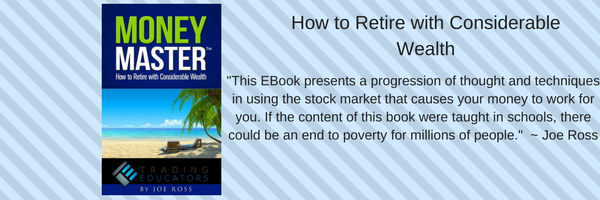
Message from Joe Ross
The knowledge contained in Money Master, belongs in every home. It should be taught in schools around the world. It belongs to both the worlds of trading and of investing. Anybody can easily find the way to consistent profits by applying the strategies revealed in this EBook.
The beauty of these strategies is that your money will work for you, as the best worldwide businesses make your money grow and compound. There is also little risk in using the strategies in this EBook - so little, in fact, that you will often not even think about risk. The strategies allow you to be as passive or as aggressive as you wish.
Highlights of what you will learn
Building the Foundation
Joe Ross wants you to think about this statement, "When I decide I want to own something, I try to buy the best quality for my money." This should also be true for you.
In Money Master, you will discover how to identify the best companies in the world, what their characteristics are, and how to apply the strategies using these great companies to make your money grow and compound.
A Different Mindset
To employ and enjoy the strategies explained in Money Master, you might have to do a complete mental turnaround. Why? Having been a day trader for many years, he used to quickly respond to the movements seen on price charts. However, with the methods you’ll see here, you’ll have lots of time to think, and to plan, as well as to act.
Joe Ross says it best. "When I bought anything as a trader, my profits were based on my expectation that prices would move higher. If prices fell, my heart, along with my hopes, fell with it. Conversely, if I sold something my anticipation was for falling prices. If prices rose, I would suffer a loss. My hope of selling high and buying back at a lower price was shattered, as was a piece of my ego."
However, with the strategies in this EBook, instead of a market meltdown causing you to panic, you won’t mind it at all. Huge market swings will no longer be a problem. You’ll be in for the longer term, and enjoy the situation both when prices rise and when they fall. You’ll have the best of both worlds while your money will be growing and compounding.
Edition 652 - December 9, 2016
Edition 652 - December 9, 2016

Finding your trading nitch in the market just got easier! Trading Educators offers several Trading Advisory Services. Select the service that fits your trading style or look into entering a different market.
 Trading on News Days - Ambush Day Trading the E-Mini S&P 500
Trading on News Days - Ambush Day Trading the E-Mini S&P 500
by Master Trader Marco Mayer
Educator for Forex and Futures, Systematic Trader, and
Creator of Ambush Trading Method, Ambush Signals, and AlgoStrats.com
This year we’ve had a couple of events that were likely to have a strong impact on the markets:
- BREXIT Decision in June
- FED Rate Raise Comments in September
- US Elections in November
- Italy Referendum in December
All of them happened over a weekend so the question many traders have been asking themselves was whether to trade on these days or not. Ambush traders have been no exception here so I got a lot of emails asking what to do.
My answer is always the same. It’s impossible to know what the actual news will be and how the markets will actually react.
What we do know though is that on such days it’s very likely that volatility will be much higher than on average. How that volatility will play out is impossible to know. In case of Ambush this means it’s much more likely on such days to either get stopped out with a big loss or to catch a really big winner. Because of that the question comes back to the trader: Take the risk or not? Another option is of course to trade less size on such days, knowing that volatility is likely to explode.
Now the good news is that on most of these events Ambush traders who have been ready to accept the risk made a killing day trading in the E-Mini S&P 500. The only even where Ambush lost was on the Trump event where the stop loss avoided bigger losses and made most of it back already on the next day.
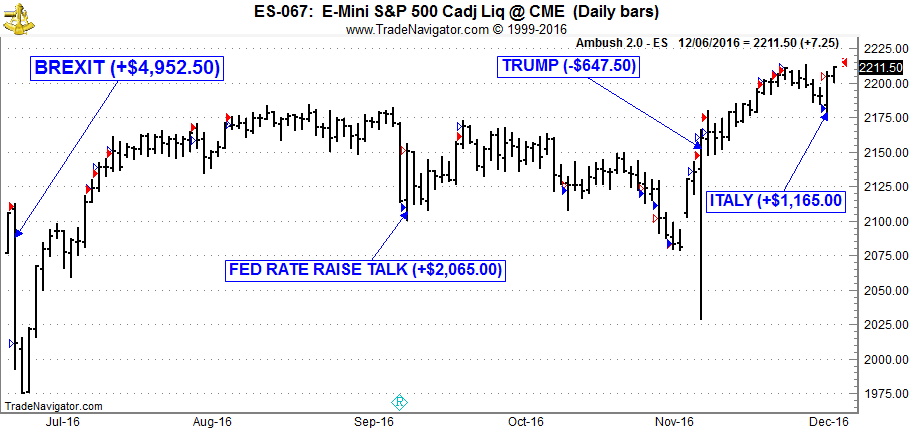
Overall Ambush had a great year in the E-Mini S&P 500 and thanks to the Italy-Trade the equity is now at new all time highs, here’s this years equity curve showing all E-Mini S&P 500 Day Trades, trading one contract including $10 per round-turn for commissions:
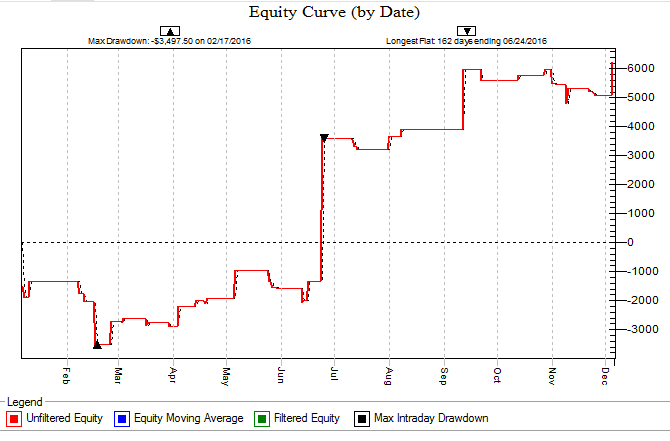
The average trade has been about $145 (including $10 commissions round-turn), which is amazing considering that Ambush is a Day Trading method, meaning you never keep positions over night!
Now if you want to become an Ambush Trader too, there’s different ways to do so. You can either buy the Ambush eBook and learn all about how the method works and set everything up yourself.
Or you join Ambush Signals and simply get access to the daily Ambush Signals for all of the supported Futures markets. This way you can just follow Ambush without having to go through the hassle of setting up charts, indicators and taking care of getting the right data and so on.
© by Marco Mayer. Re-transmission or reproduction of any part of this material is strictly prohibited without the prior written consent of Trading Educators, Inc.

The Law of Charts with Commentary
by Master Trader Joe Ross
Author, Trader, Trading Mentor, and Founder of Trading Educators, Inc.
Ledges
On the chart below we see that prices have formed an 8-bar ledge.
The Law of Charts states that a ledge begins with the profit taking that occurs during or at the end of a trend or swing. All ledges begin with Ross hooks. However, due to indecision, a sense of fair value, or confusion as to which way prices will go, the normal progression of the swing or trend does not continue.
The Law of Charts states that the percentage in favor for a successful trade is to take a breakout from a ledge in the direction of the former swing or trend. The arrow indicates that the best chance for success would be a breakout to the down side.
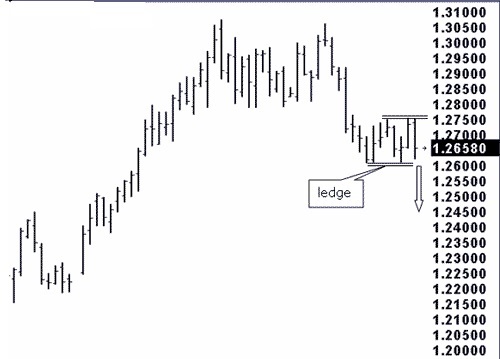
© by Joe Ross. Re-transmission or reproduction of any part of this material is strictly prohibited without the prior written consent of Trading Educators, Inc.
Trading Article - Looking at how the money supply affects trading in the markets.
by Master Trader Joe Ross
Author, Trader, Trading Mentor, and Founder of Trading Educators, Inc.
There are two important components of federal market activity which affect long- term economic activity and stock and commodity values; these are interest rates and money supply. A contracting money supply was one of the factors that caused the Great Depression of the 1930's.
In the early 1980's most traders focused almost totally on the money supply figures, which would cause cash bonds and T-Bill rates to react violently as soon as the M-1 and M-2 figures were released every Friday afternoon. The Fed Funds Rate and Discount Rate are the most important rates, and three consecutive increases or decreases establish a trend. When money supply decreases and interest rates increase, they tend to suppress economic growth.
The Fed also buys and sells government securities, through special authorized dealers, to affect the overall money supply.
Inflation becomes a problem when the CRB spot index and CRB raw industrial commodities begin to increase sharply. Stock traders will decrease holdings in interest rate sensitive stocks, like utilities, and buy cyclical stocks in the Dow Industrials, like Alcoa, or steel stocks. Expect higher interest rates to follow inflation. When interest rates move higher, T-Bonds, all T-Notes, T-Bills, and Eurodollars can be expected to feel downward pressure.
Usually, but not always, rising interest rates help the dollar as long as interest rates in the U.S. are relatively higher than those in other nations. By relatively, I mean that the differential between U.S. interest rates vs. those of competing nations is somewhat out of line to the up side.
© by Joe Ross. Re-transmission or reproduction of any part of this material is strictly prohibited without the prior written consent of Trading Educators, Inc.

Blog Post - Simplicity of Trading
by Professional Trader Andy Jordan
Educator for Spreads, Options, Swing/Day Trading, and
Editor of Traders Notebook Complete and Traders Notebook Outrights
Keeping things simple can benefit you and your bottom line in the long run. Read more.
© by Andy Jordan. Re-transmission or reproduction of any part of this material is strictly prohibited without the prior written consent of Trading Educators, Inc.
Check out our Blog!
To view previous published Chart Scan newsletters, please log in or click on "Join Us,"
shown above, to subscribe to our free "Members Only" section.
A WEALTH OF INFORMATION & EDUCATION:
Joe Ross-Trading Educators' popular free Chart Scan Newsletter has been published since 2004.
Note: Unless otherwise noted, all charts used in Chart Scan commentary were created
by using Genesis Financial Technologies' Trade Navigator (with permission).
Legal Notice and Copyright 2016 Disclaimer - Published by Trading Educators, Inc.
Chart Scan is a complimentary educational newsletter.
© by Trading Educators, Inc. Re-transmission or reproduction of any part of this material is strictly prohibited without prior written consent.
Edition 651 - December 2, 2016
Edition 651 - December 2, 2016

“What is desired in a Trader is kindness, and a poor Trader is better than a liar.” Master Trader Joe Ross

Traders Notebook Outrights
by Professional Trader Andy Jordan
Educator for Spreads, Options, Swing/Day Trading, and
Editor of Traders Notebook Complete and Traders Notebook Outrights
I want to present an outright futures trade we had this week in Traders Notebook Outrights. We went long the Crude Oil at 47.00 on 11/30 with a risk of $600 per contract on the “normal” futures contract (the risk per contract on the E-mini CL was only $300). We reached our first target at 47.60 an hour later (first gray horizontal line) and the second target at 48.80 on the same day (second gray horizontal line). We are still holding the last lot using a trailing stop with a possible target at 51.80.
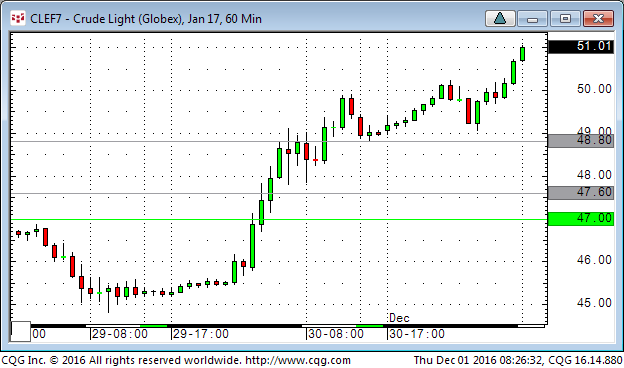
If you are interested in this kind of swing trades, our newsletter service Traders Notebook Outrights is the right choice for you. If you have any questions, please do not hesitate to contact me at This email address is being protected from spambots. You need JavaScript enabled to view it..
© by Andy Jordan. Re-transmission or reproduction of any part of this material is strictly prohibited without the prior written consent of Trading Educators, Inc.

The Law of Charts with Commentary
by Master Trader Joe Ross
Author, Trader, Trading Mentor, and Founder of Trading Educators, Inc.
Time Independent Charts
If you want to trade a chart that is time-independent, you have two choices:
- Point and figure charts
- Tick charts
To create a tick chart you need software that will enable you to do so. I use Genesis Trade Navigator. Instead of each bar on the chart representing a specific amount of time, each bar represents a specific number of ticks. Tick charts change the entire structure of the prices you are looking at. The magnitude of the moves changes markedly, as well as having trends appear where there is no trend with charts based on time. The time between bars also varies. At a setting of 500 ticks per price bar, you might find an hour or more between bars, or a matter of minutes between bars, depending upon the liquidity of the market you are trading.
One of the nicest things about tick charts is that you can literally create them to match your own style of trading. Your chart for each market can be unique to you and you alone. The number and variety of tick charts is virtually unlimited. Someone trading a bar chart in which each bar contains 257 ticks is going to see a different chart from the person trading a bar chart in which each bar contains 250 ticks.
The chart below was sent in to me by one of our subscribers. It is a chart of the e-mini S&P. Each bar contains 1,000 ticks. This is the text that accompanied the chart: "Another example of using price bars and price bar relationships correlated with 15-min and 60-min charts. After a large go down, it is reasonable to have it go back up some."
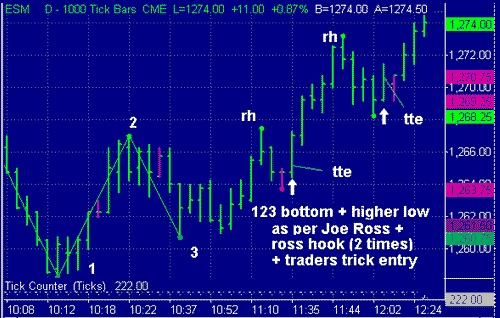
© by Joe Ross. Re-transmission or reproduction of any part of this material is strictly prohibited without the prior written consent of Trading Educators, Inc.
Instant Income Guaranteed - TWX Trade
Developer: Joe Ross
Administration and New Developments: Philippe Gautier
Check out our newest IIG example which produced for our subscribers a $25 Profit (Average), $1,370 Margin, and 111.01% Return on Margin Annualized. Read more.
We have also added new types of trades for our IIG daily guidance, "no loss" propositions with unlimited upside potential, still using other people's money to trade .
Instant Income Guaranteed
© by Joe Ross and Philippe Gautier. Re-transmission or reproduction of any part of this material is strictly prohibited without the prior written consent of Trading Educators, Inc.
Blog Post - "Once I’ve achieved success as a trader, then what? I’ve heard that after a while trading can become boring."
by Master Trader Joe Ross
Author, Trader, Trading Mentor, and Founder of Trading Educators, Inc.
I know you would all like to have that problem, but I can vouch for its being true. I always have to find new ways to trade or I do become bored. However, I have never run out of ways to trade that remain exciting, at least for a fairly long time. Read more.
© by Joe Ross. Re-transmission or reproduction of any part of this material is strictly prohibited without the prior written consent of Trading Educators, Inc.

Say Hello to Ambush Signals
by Master Trader Marco Mayer
Educator for Forex and Futures, Systematic Trader, and
Creator of Ambush Trading Method, AlgoStrats.com
Rave reviews are already coming in!
"Subscribed and loving it. Now I just look at the numbers generated for what I want to trade and put the orders in with my broker. It's just that easy. It's pretty much point and click. I really feel empowered and way more confident now, thanks to the service." DR, Michigan
You will be excited to learn about our new service, Ambush Signals for the Futures markets. Watch my short presentation to find out more about Ambush Signals.
Yes, I want to become an Ambush trader!
© by Marco Mayer. Re-transmission or reproduction of any part of this material is strictly prohibited without the prior written consent of Trading Educators, Inc.
Check out our Blog!
To view previous published Chart Scan newsletters, please log in or click on "Join Us,"
shown above, to subscribe to our free "Members Only" section.
A WEALTH OF INFORMATION & EDUCATION:
Joe Ross-Trading Educators' popular free Chart Scan Newsletter has been published since 2004.
Note: Unless otherwise noted, all charts used in Chart Scan commentary were created
by using Genesis Financial Technologies' Trade Navigator (with permission).
Legal Notice and Copyright 2016 Disclaimer - Published by Trading Educators, Inc.
Chart Scan is a complimentary educational newsletter.
© by Trading Educators, Inc. Re-transmission or reproduction of any part of this material is strictly prohibited without prior written consent.
Edition 650 - November 25, 2016
Edition 650 - November 25, 2016


Dear Friends,
Whenever this time of year rolls around, I find myself with an attitude of gratitude. This week we celebrated Thanksgiving Day. Although "Thanksgiving" is not celebrated here in Uruguay, many living here celebrated at various places around the country. There were at least fifty people at the gathering my wife and I went to.
Trading and markets have been a major part of my life for almost 60 years. Trading has been the means through which my family and I have received many blessings.
I am grateful that I’ve been able to share those blessings with my many students. I am thankful for each and every one of you. Trading can be a lonely business, especially if you selfishly keep entirely to yourself what you know and have learned. At Trading Educators, it’s just not in us to be that way.
I wonder if you realize how rare it is to find traders, who are not only successful with their own trading, but are also willing to help others to achieve success?
A few days ago, as I was looking at our website, I stumbled across a brief statement of our philosophy at Trading Educators. I wonder how many of you have read it, and have truly given it some serious thought?
"Teach our students the truth in trading — teach them how to trade,"
and
"Give them a way to earn while they learn — realizing that it takes time to develop a successful trader."
All of our staff and associates truly believe in these ideas, and we work hard to bring you the best we have to offer because your success is our success.
Having been through the steps ourselves, we know how difficult it can be to one day realize that you are able to trade for a living - to realize that you have finally made it! There are so many times when you are ready to give up; So many times when you feel defeated. Trading looks easy, but once you are involved you realize that it takes great dedication, and persistence to reach the top. The toughest part of trading is learning to master yourself.
We want to encourage you to keep at it. Don’t give up. The rewards are greater than you think.
For those of you who celebrated Thanksgiving Day, we hope it was a terrific day for you. For those of you who live in countries where there is no Thanksgiving Day, perhaps you should give it a try. Set aside a day to be thankful for what you have. Everyone has something to be thankful for. At Trading Educators we are thankful that we have so much to share with all of you.
As always, wishing you all the best,
JR
© by Joe Ross. Re-transmission or reproduction of any part of this material is strictly prohibited without the prior written consent of Trading Educators, Inc.

Be sure to check your inbox for our Cyber Monday specials!
Visit our Blog!
To view previous published Chart Scan newsletters, please log in or click on "Join Us,"
shown above, to subscribe to our free "Members Only" section.
A WEALTH OF INFORMATION & EDUCATION:
Joe Ross-Trading Educators' popular free Chart Scan Newsletter has been published since 2004.
Note: Unless otherwise noted, all charts used in Chart Scan commentary were created
by using Genesis Financial Technologies' Trade Navigator (with permission).
Legal Notice and Copyright 2016 Disclaimer - Published by Trading Educators, Inc.
Chart Scan is a complimentary educational newsletter.
© by Trading Educators, Inc. Re-transmission or reproduction of any part of this material is strictly prohibited without prior written consent.






